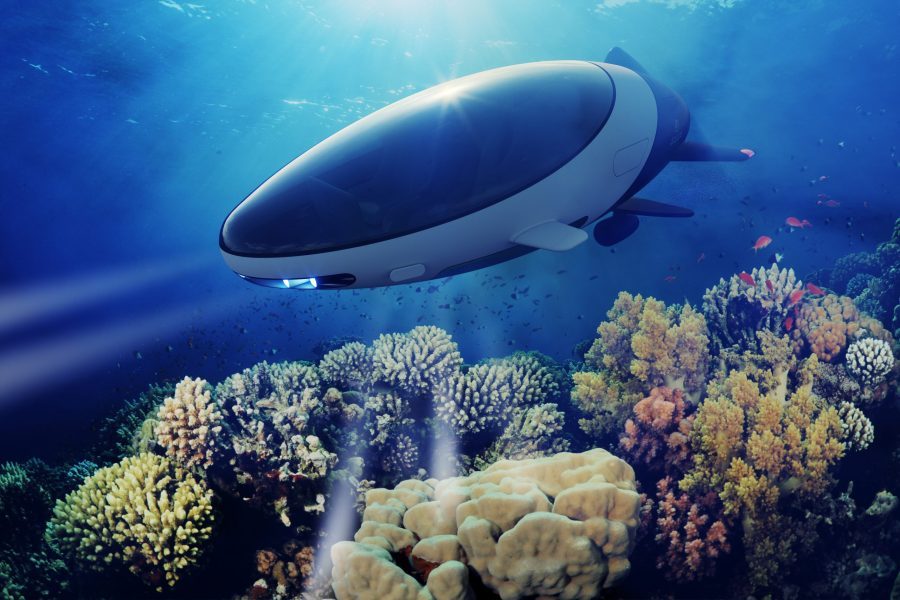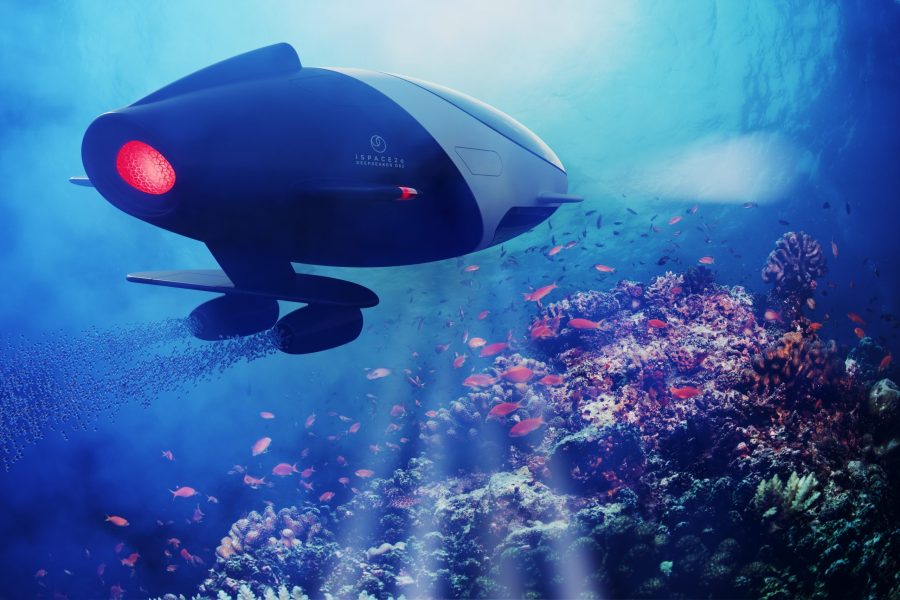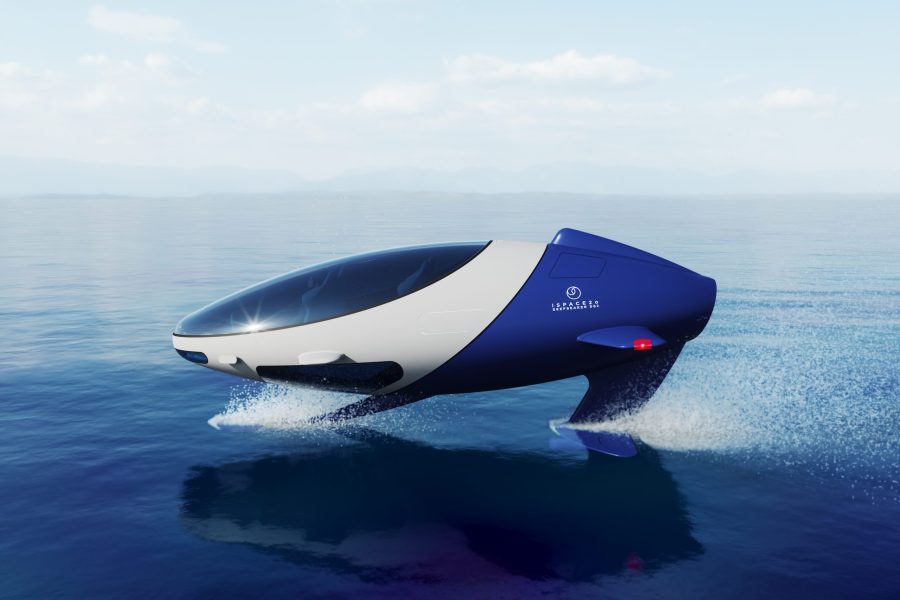A unique and patented ‘artificial gill’ breathing system is one of the eye-catching features of the forthcoming DeepSeaker – a craft designed to function as both a high-speed hydrofoil and a high-tech mini-sub
Imagine a compact craft capable of shooting across the surface at high speeds on retractable hydrofoils, before plunging 50m beneath the surface to function like a mini-sub. That’s the concept behind the design of the DeepSeaker, an electric submersible hydrofoil vehicle that has been developed for the superyacht sector by Italian start-up iSpace2o.
Measuring 5.5m x 1.8m, pressurised to 1ATM and featuring a gross weight of 3,500kg (including 400kg payload capacity), the DeepSeaker (currently the DS2 model, an evolution of the earlier DS1) has received design input from Rome-based architecture firm Giancarlo Zema Design Group. The craft features an internal, carbon-built cockpit, positioned in a steel ribcage and then covered with a thermoplastic body, to provide durable protection for the interior even if the boat impacts with another vessel or object. The interior is laid out to accommodate up to four passengers, seated in a ‘2+2’ car-style configuration.
As such, yacht owners could entertain their guests by launching the DeepSeaker from the yacht and piloting it towards sites rich with fauna and flora (where the yacht’s diesel engines may not be welcome), and then retracting its hydrofoils and submerging to explore the seabed, for example. To this end, the DeepSeaker is equipped with a digital dashboard featuring iPad connectors, Go-Pro cameras and hydrophones, allowing the occupants to listen to the marine mammals outside and to capture footage of these memorable sights.
Surface and submerged
The DeepSeaker’s propulsion is provided by dual 210kW DeepSpeed pods, supplied by Sealence. Both pods are attached outside the hull – specifically, to the back end foil – and incorporate electric jets for minimum turbulence and wake. The DeepSeaker is a 100% electric vehicle, powered by lithium-ion (Li-ion) batteries that offer six to eight hours of cratt autonomy. iSpace2o calculates that it should take eight hours to recharge the DeepSeaker’s bafteries from the quayside when time isn’t of the essence – or in one hour, in fast recharge mode, using marine recharge columns designed by Giancarlo Zema Design Group for UnicoGo. The long-term plan is for the craft’s electric engines to be fuelled by hydrogen.
With its hydrofoils deployed, the DeepSeaker managed to aftain 52knots within six seconds during a trial of the DS1 version. However, Giuseppe Carusi, iSpace2o CEO, tells Ship & Boat International: “With two motors, we may easily exceed the 52knots mark, but they are primarily intended for redundancy: we intend to limit the speed for safety reasons.” There is also battery charge life to consider, and so a foiling speed of 25knots has been deemed more practical. When the end user does fancy a white-knuckle ride, speeds of 35knots+ are possible in foiling mode.
Obviously, the ‘submerged mode’ considerations for the DeepSeaker DS2 necessitated a high degree of safety preparedness. The vehicle is equipped with a perimeter airbag that inflates with air in the event of an emergency, so that it can quickly ascend to the surface. Other onboard safety devices include a CO2 level alarm, a depth pressure reader and a 3D depth sounder, plus emergency air canisters for occupants, seat belts and GPS.

The DeepSeaker DS2 can fly across the surface on hydrofoils, before diving down to 50m
Additionally, the DS2 incorporates a monitoring system to prevent the craft from descending deeper than 50m (about 6bar of pressure) and to keep tabs on its speed and battery consumption, to reduce the risk of the craft becoming stranded at sea.
Air from seawater
One of the most notable safety features, however, is the craft’s ‘artificial gill’ system: a patented solution developed by iSpace2o partner Like-A-Fish Technologies, which has been designed to extract dissolved, breathable air from seawater during the craft’s transits. Alan Bodner, scientist and founder of Like-A-Fish, tells Ship & Boat International: “The extracted air will be supplied through the cabin air supply, which will include modules for drying the air and for CO2 scrubbing: these are modules that [usually] exist in submarine air supply systems” (see below).
The Like-A-Fish system will supply all of the oxygen needs for the DeepSeaker’s occupants, thereby removing the need for heavy and space-consuming oxygen tanks – although Bodner recommends also having at least one oxygen tank on board as back-up. It’s estimated that the breathing system will consume approximately 150W of power per occupant – again stressing the importance of the onboard battery-monitoring system.
Staying with innovative features, iSpace2o has also contracted energy solutions provider MIEGG, also based in Italy, to help build and test a patented hydrogen range extender for the DS2 version of the DeepSeaker. The extender is described by MIEGG founder Angelo Minotti as “a high-power miniaturised electric generator, characterised by a revolutionary combustion chamber and powered by hydrogen”.
The extender will be capable of generating 80120kWe, providing additional charge to the bafteries. MIEGG claims: “The use of this power system will reduce the Li-ion baftery pack from the 600kg needed to provide up to 240 minutes of navigation and 30 minutes of diving, down to about 80-100kg.” With this saved weight being used to load the required volume of hydrogen, MIEGG predicts that the DeepSeaker could extend its operational range “from five to seven times”, and without any emissions. What’s more, the extender’s components will be 3D-printed, for minimal environmental impact.
Futuristic aesthetic
The craft will also be equipped with a ‘heads up display’ (HUD) system, incorporating augmented reality (AR) technology developed by HoloMask, to superimpose vital information (such as the aforementioned battery- /depth-monitoring data) on the display, so that it remains constantly visible to all occupants – a reassuring safety feature, and one sure to add to the DeepSeaker’s overall futuristic aesthetic.
The vehicle and its hull will be developed by Blaze Performance, one of the competitor teams in the Formula 1 H20 world championship, with financial backing provided by a loan from Invitalia, a subsidiary of Italy’s Ministry of Economy and Finance. “We are aiming to complete the first prototype by the end of 2023, so production is not foreseen before 2024,” Carusi explains.
Prices for the DeepSeaker are expected to start from around €950,000 (US$1.03 million), suggesting that this toy will be best suited to high-end yacht owners – although it has been reported elsewhere that an unspecified cruise line has taken a particular interest in this innovative, versatile vehicle. There would also appear to be plenty of mileage in tour companies and resorts renting out the DeepSeaker for the benefit of guests and VIPs.

The DeepSeaker DS2 will carry up to four occupants, protected by a tough combination of carbon, steel and thermoplastic
How the ‘gill’ system works
The Like-A-Fish system was originally designed for use by scuba divers, providing them with low-weight ‘artificial gills’ when operating underwater.
The system has been developed to separate dissolved air from the water by applying low pressure – “according to Henry’s Law, which states that the amount of a gas that can be dissolved in a liquid is proportional to the pressure on the liquid”, Like-A-Fish says. “Reducing the pressure will cause dissolved gas to be released from the liquid” – a similar scenario to when a bottle of soda is opened, the company adds.
“Reduction of the pressure will be achieved by using a centrifuge, causing lower pressure in the centre,” Like-A-Fish continues. “Atter separation, the air is transferred to an air bag for use by the diver.” However the company believes this technology can also be applied to naval submarines, underwater scooters and underwater habitats – and, of course, luxury submersibles, for which the DeepSeaker will serve as a demonstrator.






